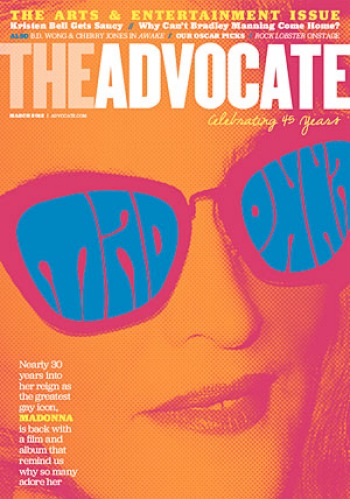
When I tried to kill myself (yeah, I’m bringing that one out of the bag — just check out this issue of Xtra’s Blitz & Shitz), my mother was in New York City. When she returned, and I came back to life (after three days of wildly traumatizing anti-psychotic overdose-induced hallucinations), she gave me a souvenir — a drawing of Madonna by a street artist outside Central Park. It’s a picture from Madonna’s Ray of Light album. The look in her eyes evokes independence. I often look at it to motivate myself. I have taken it with me everywhere I’ve lived, from my bedroom growing up in the Prairies, to every rat- and cockroach-infested hell hole I inhabited in New York, to here on the West Coast. It’s one of my most cherished possessions because it represents my rebirth. When I was a confused and angst-ridden 15-year-old, Madonna made me feel there was hope. She was this scrawny little bitch from nowhere, yet she made her dreams come true, helping me believe I could too.
Her entire life Madonna has been a part of the gay community. Her first mentor was her gay ballet teacher, Christopher Flynn, who inspired her to move to New York in the late ‘70s. The new issue of The Advocate celebrates her legacy as a part of our culture. We’re the ones sacrificing those $300 dollar handbags (or in my case, food) to see her perform live (because she’s worth it).
On the beginning of the AIDS epidemic in ‘80s New York: “I was extremely affected by it. I remember lying on a bed with a friend of mine who was a musician, and he had been diagnosed with this kind of cancer, but nobody knew what it was. He was this beautiful man, and I watched him kind of waste away, and then another gay friend, and then another gay friend, and then another gay friend. They were all artists and truly special and dear to me.”
On her gay fans feeling abandoned: “I never left them. When you’re single, you certainly have more time to socialize and hang out with your gay friends, but then you get married and you have a husband and you have children, and your husband wants you to spend time with him. I’m not married anymore, but I have four kids, and I don’t have a lot of time for socializing. I hope nobody’s taking that personally. It certainly was not a conscious decision. As it stands, most of my friends in England are gay. But I’m back. Never fear.”
 Why you can trust Xtra
Why you can trust Xtra


